From the earliest days of portraiture, paintings representing betrothal and marriage predominated. So when commercial photography developed in the 1840s, these important events continued as favoured pictorial themes. Most of us have old family wedding photographs in our collections, from paired or double Victorian studio portraits, to extended outdoor group scenes. Early studio marriage photos may go unnoticed, for newlyweds generally posed in their fashionable ‘Sunday best’, without flowers or other distinguishing attributes.
Wedding photographs are heirlooms to treasure, and to learn from. They provide an exact visual representation of the official marriage records on which we all depend to construct our family tree. Many portray groups of relatives all in one place, which is very helpful when making meaningful connections between various individuals. Some include the only known depiction of an otherwise camera-shy ancestor, or, conversely, portray forebears seen in other photographs, confirming suspected identities and forming a firm point on our ancestral visual timeline.
Photographs of weddings, whether economical and simple or grand and impressive, are also sentimental pictures that have been carefully preserved and retain a strong emotional value today. They often record the best times in our forebears’ lives, and sometimes details in wedding pictures demonstrate tangible links down the generations, like a beloved wedding dress or veil worn by successive brides over the years.
Some wedding photographs are firmly identified, while others survive without names or dates. This guide helps with successfully dating and contextualising some of our most beautiful, interesting and important family heirlooms.
Country house wedding scene, Hawkhurst, Tunbridge Wells, Kent, October 1869

Following technological advances facilitating outdoor photography, in the late 1860s wealthy families began to hire photographers to visit the reception venue. This ‘white wedding’ scene was taken at the home of the bride, the daughter of a railway engineer.
- White bridal attire, attendants and flowers – the desirable ‘white wedding’ – were initially limited to affluent ancestors, occurring in outdoor photographs like this from the late 1860s onwards.
- At an 1860s ‘white wedding’ the bride and bridesmaids all had white gowns, white veils and posy bouquets – a good dating clue, but hard to tell them apart!
- Since this is an upper-middle-class wedding, these men all wear formal, knee-length frock coats with boutonnières (floral buttonholes) in their lapels and contrasting fashionable lighter trousers.
- A young boy sitting on the floor in front wears a picturesque velvet costume. This knickerbockers suit was a new style established during the 1860s.
Studio carte de visite, early 1870s
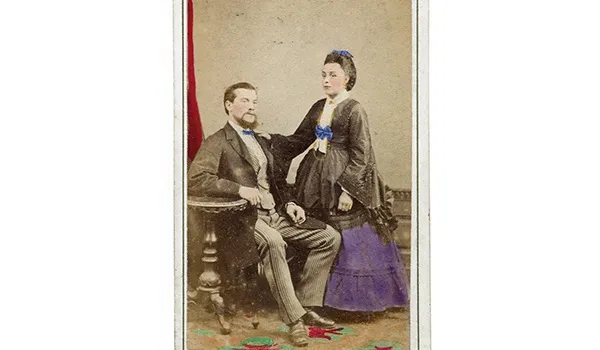
This card-mounted photograph typifies many ordinary Victorian wedding pictures. The couple visited their local studio after the service, wearing fashionable ‘Sunday best’ outfits but, typically, displaying no floral accessories. Between the 1860s and 1880s most wedding photographs used the carte de visite format, measuring about 2.5 inches by 4 inches. This example is hand-tinted, showing the genuine colours of the clothing.
- This photograph is identifiable as a classic studio wedding portrait. The couple’s intimate pose implies their relationship and the bride clearly displays her wedding band, highlighted in gold.
- We can date this image to c1870–1874 because of the bride’s hairstyle incorporating thick chignon behind her head and her layered costume displaying bustle drapery at the back.
- It looks as if the bride might be pregnant. Many brides were when they married, but rarely revealed the fact in photographs. Otherwise the bulge might possibly be bulky drapery!
- The groom wears a high-fashion narrow-fitting suit, the coloured trim or piping outlining the outer trouser leg seams a dress detail associated mainly (but not exclusively) with the 1870s.
Outdoor wedding scene, mid-1890s

Advances in outdoor photography during the late 1800s encouraged wedding group scenes. Special bridal wear and costly ‘white weddings’ weren’t yet common, but ordinary brides often wore a veil and other white accessories.
- This photograph can be firmly dated to the mid-1890s from the fashion clues, especially the women’s ‘leg-of-mutton’ sleeves, at their widest in 1895/1896.
- Typically this bride wears a fashionable pastel-coloured day dress, accessorised with a special white veil, striking lace collar, white gloves and bodice corsage.
- The bridesmaid (left) wears clothes and accessories similar or possibly identical to the bride, but, as usual around the century’s turn, a fashionable hat not a veil.
- The men’s stiff bowler hats, starched winged shirt collars, white neckties, gloves and boutonnières are all typical of ordinary weddings of the era.
Outdoor wedding scene, April 1913
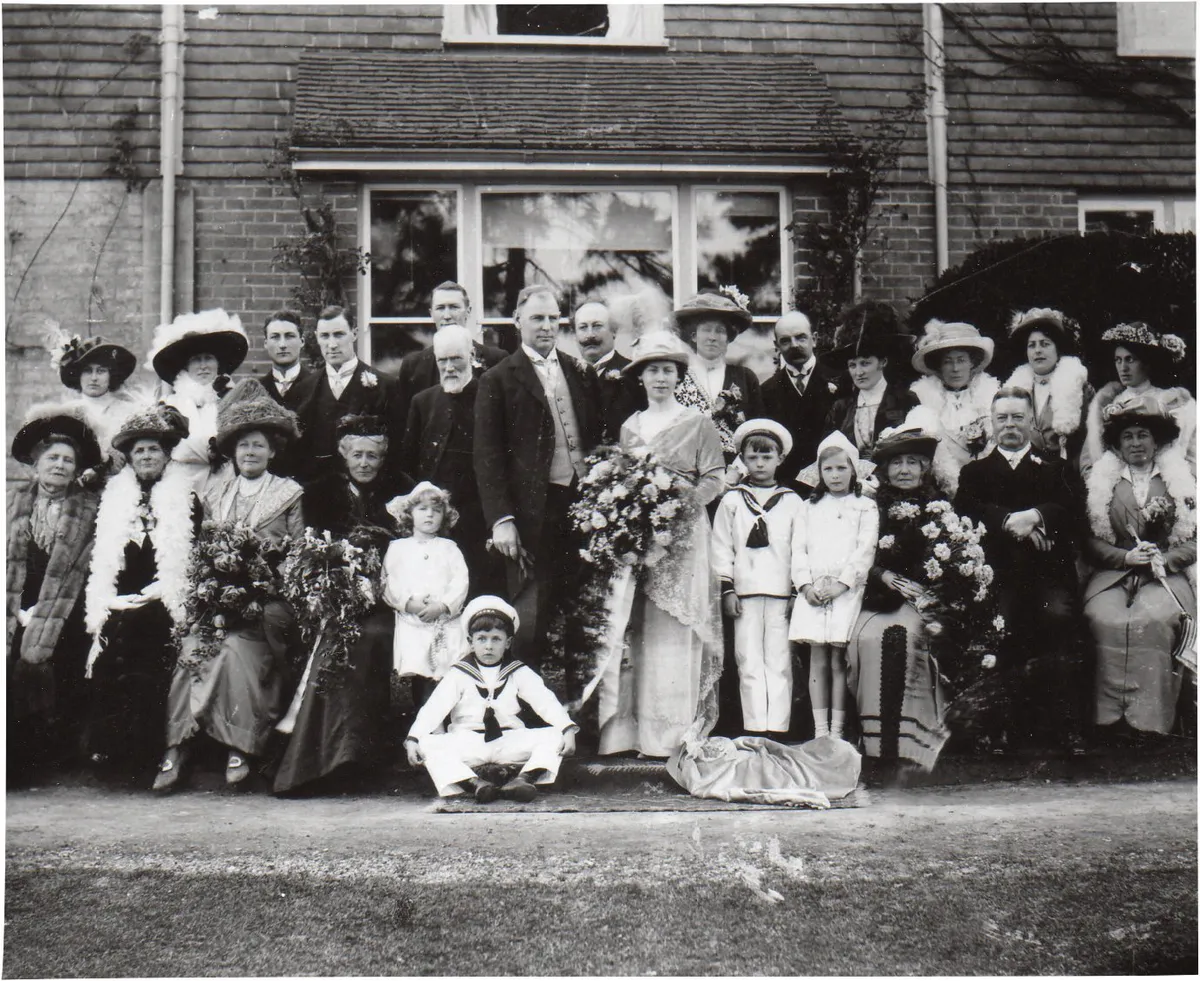
Both outdoor photography and ‘white weddings’ became widely established in the early 1900s. This bride is the daughter of the bridal couple depicted in the photo from 1869.
- This bride’s slender, asymmetrical grey gown is typical of the era.
- Her ensemble was described in the Kent & Sussex Post as “silver-grey chiffon velvet with court train draped with Brussels lace veil (worn by her mother on her wedding day)”.
- In 1913 affluent grooms often wore sloping morning coats, as here, or more traditional longer frock coats, with gloves and boutonnières.
- Young pages and flower girls were increasingly popular. Page boys often wore white sailor suits.
Garden wedding scene, Croydon, 1923
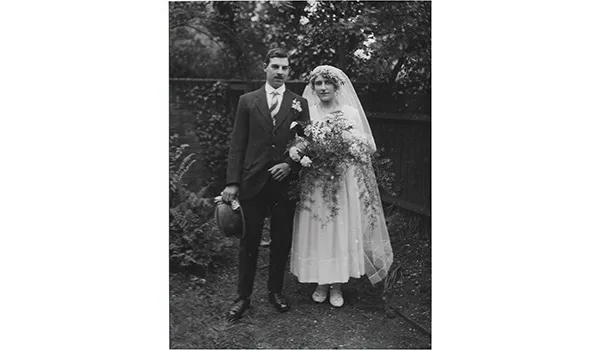
After the First World War, when weddings were often hurriedly organised, a new generation of brides revived the romantic ‘white wedding’, many wearing white bridal dresses with veils, as here. Some photographs were taken in the studio, but more often outdoors, commonly in the family garden. Several different photographs of this occasion survive.
- During the 1920s bridal caps or floral wreaths attached to veils were invariably worn well forward, or low on the forehead.
- Bridal hemlines followed daytime dress fashions throughout the 1920s. Early in the decade they were set at around low-calf-length, stockings and shoes also white for summer weddings.
- The groom, a working man, wears a slender lounge suit with a long, single-breasted jacket; short, narrow trousers; and a starched turned-down shirt collar typical of the early/mid-1920s.
- Modern male wedding accessories between the wars included a boutonnière, gloves and felt trilby- or fedora-style hat with dented crown, as seen here.
Church wedding scene, July 1939
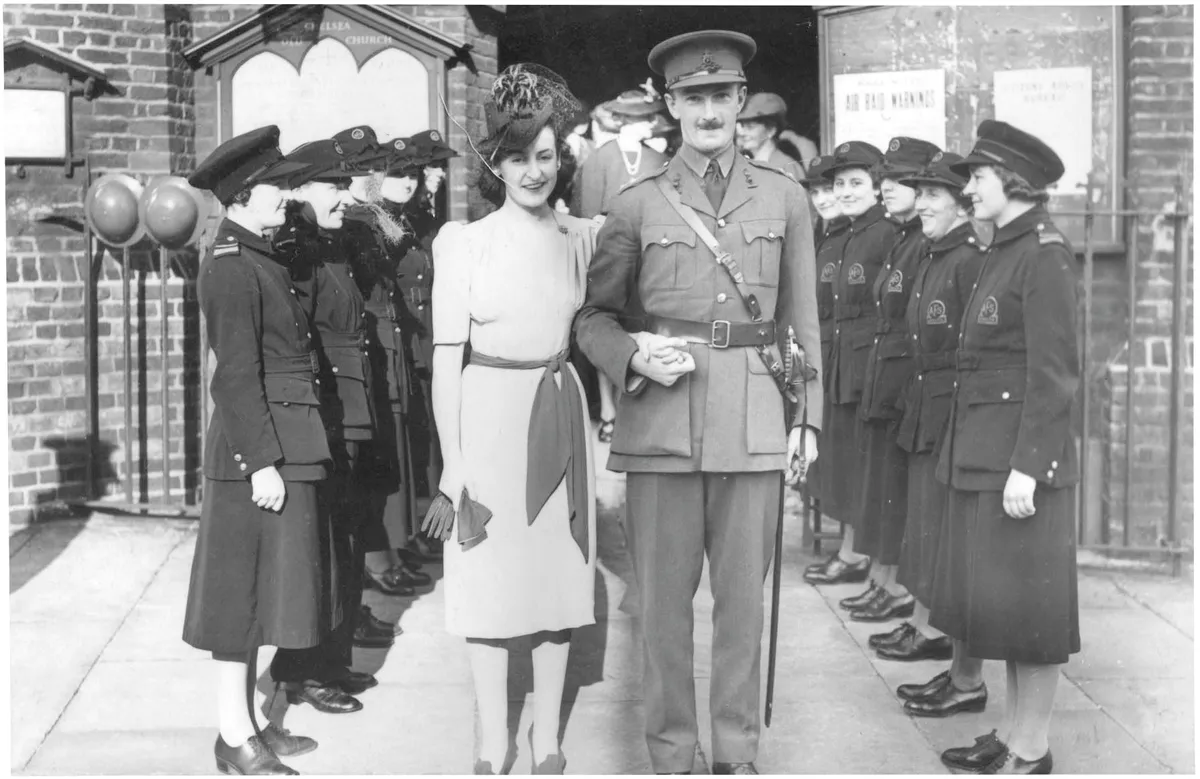
As the Second World War loomed, and for as long as the conflict lasted (1939–1945), grooms usually married in service uniform, as here, while brides either wore traditional ‘white wedding’ ensembles or smart civilian clothes.
- In the 1930s views of the front porch or lichgate of the church where the marriage service occurred were popular in ordinary wedding photography.
- Military or quasi-military uniforms often indicate that a wedding occurred around wartime. Uniform experts can identify the organisation plus the wearer’s role and rank.
- A guard of honour was common at this time, the bride’s colleagues in formation here dressed in the uniform of the Auxiliary Fire Service (AFS), formed in January 1938.
- The bride’s trim knee-length dress with padded shoulders and puffed sleeves was fashionable in the late 1930s and early 1940s. So was her jaunty veiled asymmetrical hat.
Church wedding scene, October 1944
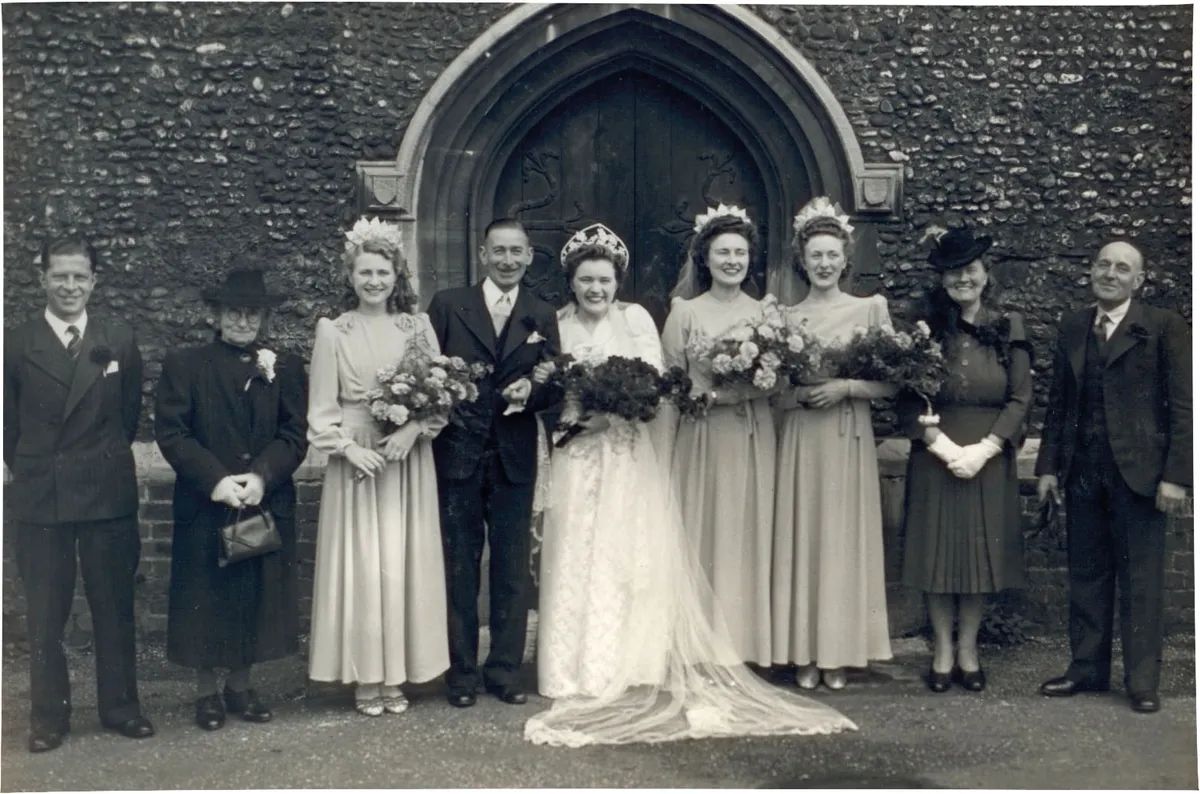
Many 1940s wedding photos were taken after the service, outside the church, as here. By 1944 clothes rationing, utility and austerity guidelines were well established, favouring slender, relatively unadorned garments.
- The bride’s slender, untrained gown in figured white ‘bridal satin’, long veil and wired headdress are typical of the era.
- The groom, in a reserved occupation, wears a civilian suit that follows most utility guidelines in its moderate cut, although, like many men, he contrived trouser turn-ups.
- The bridesmaids wear fashionable, wide-shouldered, pale blue crêpe de Chine dresses together with characteristic tiara headdresses; the adult bridesmaids’ short veils were a distinctive 1940s trend.
- The bride’s mother (right) wears a tailored dress, the skirt pleats typical of the 1940s. Her angled felt hat is also fashionable, her fox-fur stole favoured by mature women.